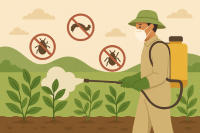
Apply Fipronil early in crop stages to target pests before damage begins; timing ensures maximum protection.
Fipronil is a slow-acting, contact and ingestion-based insecticide. Its residual effect makes it effective over a long period, especially in soil applications. That makes it ideal for managing pests like stem borers, termites, and leaf folders, which often don’t exhibit visible symptoms immediately.
What makes it distinct is its translaminar activity—it doesn’t just stay on the surface but penetrates plant tissue. This makes it an excellent fit for early-stage applications before visible outbreaks occur.
The best time to apply Fipronil varies by crop but generally falls within these windows:
At this point, leaf folders and stem borers begin to appear. When insect populations start to rise, a foliar spray or granular application guarantees that the developing crop has internal protection.
For instance, the infestation of stem borer in rice peaks 20–40 days after transplanting. During this window, products such as Bay Jump WG and Fipronil 80 WG work well. It is appropriate for paddy fields with fluctuating water levels because of its WG formulation, which guarantees improved leaf adherence and constant release.
Farmers often overlook this detail, but the time of day also affects insecticide performance. Fipronil should ideally be applied during cooler hours—early morning or late afternoon. High temperatures in midday can accelerate evaporation or reduce absorption, particularly in dry or windy conditions.
Humidity also plays a role. In humid regions like West Bengal or Kerala, the absorption rate increases, which can enhance residual action. In contrast, arid areas like Rajasthan may require slightly higher dilution volumes to achieve effective coverage.
“Pest control is not about reacting to damage; it’s about anticipating it before the enemy settles.”
– Rural Extension Officer, Madhya Pradesh
Rice:
Apply during the early tillering stage or when moths are spotted during field scouting. Use a water-dispersible formulation for better canopy coverage.
Sugarcane:
Best applied during planting or within 30 days after planting. Soil incorporation ensures strong protection of the root zone against termites and borers.
Maize and Sorghum:
Foliar sprays between 15 and 30 days after sowing offer good control against shoot fly and armyworms.
Groundnut and Soybean:
Fipronil in seed treatment or early foliar spray helps curb termite and soil pest issues in sandy soils.
Fipronil works; however, using it excessively can have unexpected side effects. Concerns over chemical resistance, diminished biodiversity, and secondary pest outbreaks are growing.
Once more, timing is a protective measure in this situation. By focusing on the initial pest wave, beneficial insect exposure is reduced, and subsequent applications are not as necessary.
Using the correct Fipronil formulation is essential for optimal absorption and safety. WG (water-dispersible granules) and SC (suspension concentrates) are better suited for Indian field conditions due to their heat stability and leaf adherence. EC (emulsifiable concentrates), while fast-acting, tend to evaporate quickly and may pose environmental risks.
The ideal application time isn’t fixed—it depends on the results of pest surveillance. Tools such as pheromone traps, light traps, and field scouting provide early warning signs.
Farmers should look for:
Based on this, adjust timing to apply Fipronil right before the larval hatch, when pests are most vulnerable and haven’t yet entered the plant’s protected tissues.
© 2024 Crivva - Business Promotion. All rights reserved.